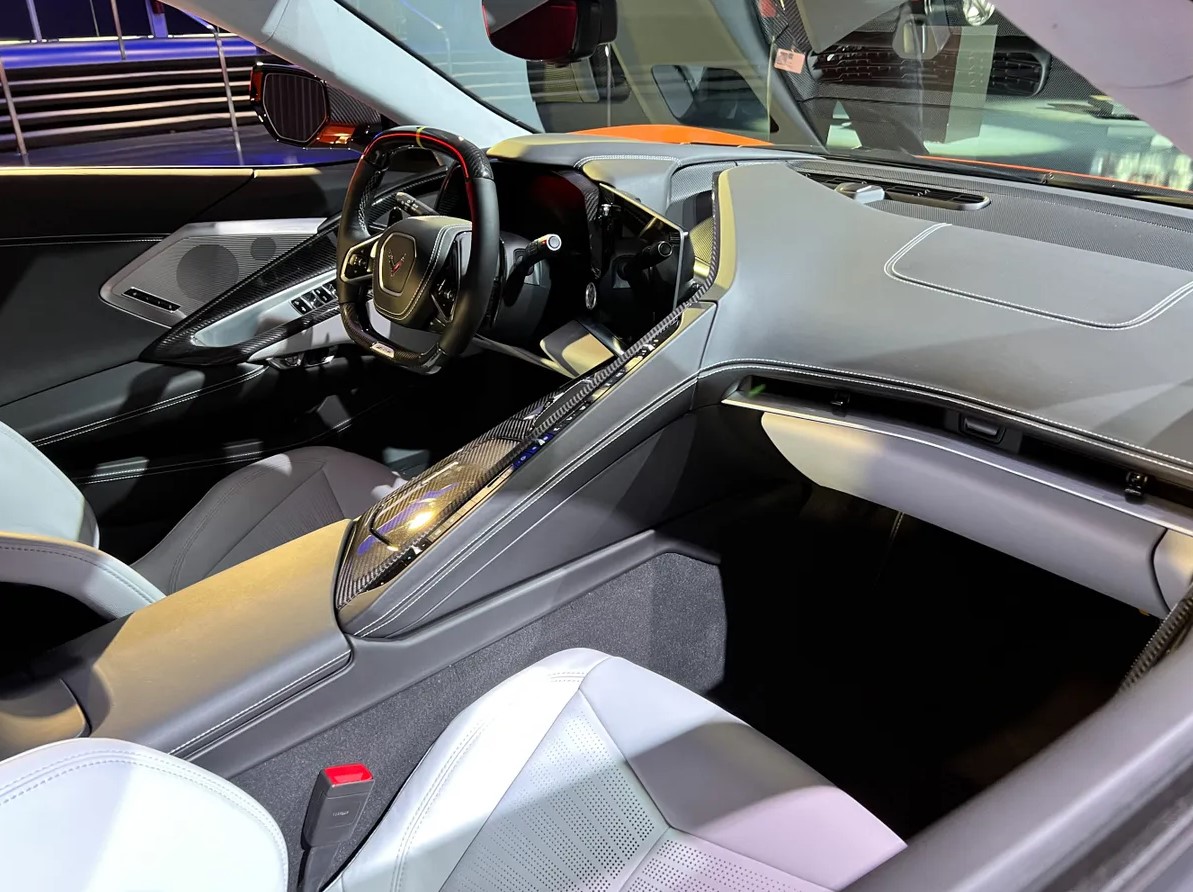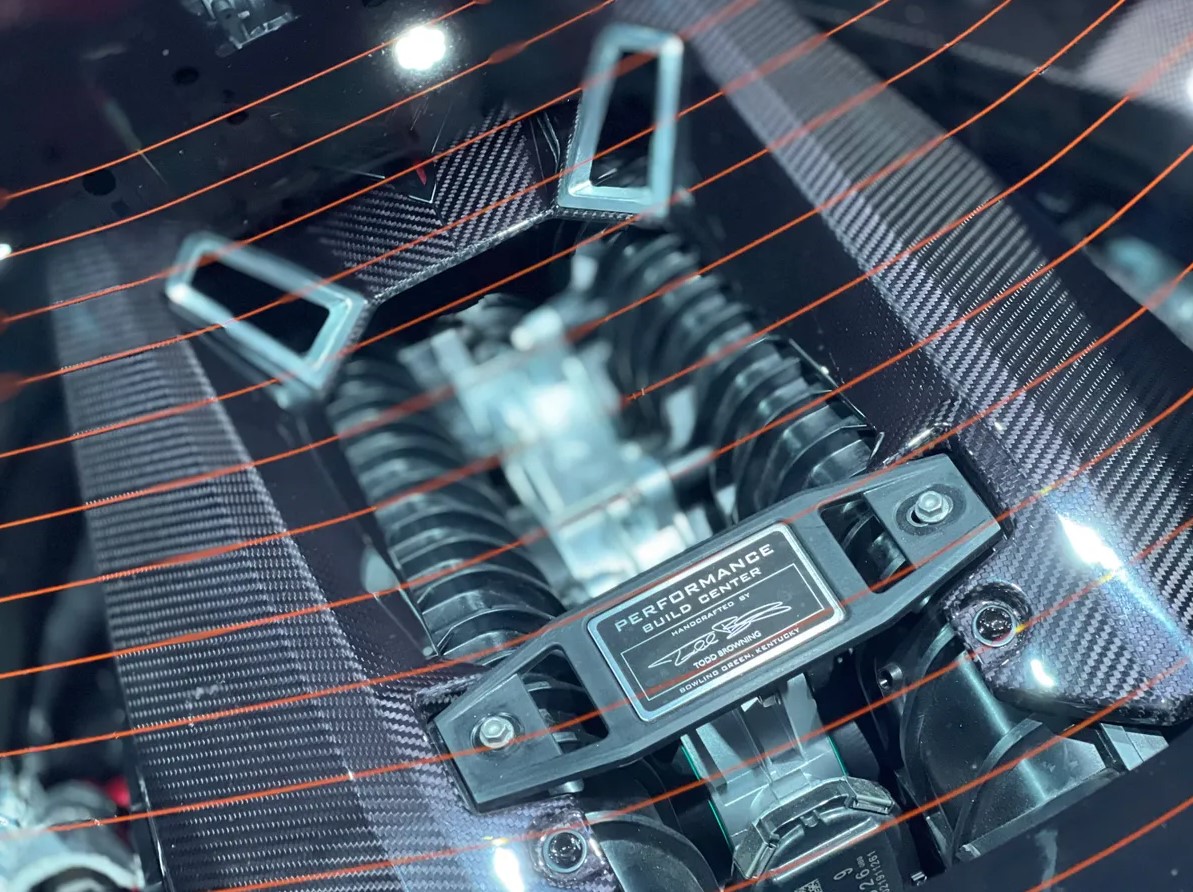2026 Chevy Corvette Z06 Specs, Changes, Performance – Come learn about the LT6 flat-plane-crank V8’s unique technical characteristics. It could be the last of its kind. Z06: Those three individuals have consecrated just a small number of corvettes. These racetrack-bred apex predators might damage vehicles that cost twice or three times as much. The upcoming 2026 Chevy Corvette Z06 will continue this legendary tradition of all-American whoop-ass, thanks in part to a new world-beating V8.
Chevy’s hand-built LT6 is one of the most interesting power plants to be developed in the last decade or more. The most potent engine ever mounted between the fenders of a production vehicle is this 5.5-liter naturally aspirated V8 engine, which was initially utilized in race vehicles. This flat-plane-crank engine spins at an amazing 8,600 rpm and generates an amazing 670 horsepower and 460 pound-feet of torque without the need for forced induction.
When you read figures like that, it’s hard to argue against the engine’s performance, but you may talk about its history. Since 1955, GM engineers have referred to the LT6 as a small-block engine. This new V8 is entirely different, even though it has the same 4.4-inch bore spacing as Chevy’s famous “mouse motor” that was produced for many years.
Before beginning this study endeavor in 2014, GM engineers benchmarked several competing power units from rareified manufacturers like as McLaren and Porsche. According to Lee’s remark, “we looked intently at Ferrari.” His team even purchased the engine from a broken Ferrari 458 Italia in Poland for $25,000 on eBay.
Even while they carefully studied the rivals, Lee declared, “This is a GM engine design that we’ve done completely in house,” without outside assistance as some have speculated. The LT6 is made of clean sheets and has a bore spacing of 4.4 inches.
“We maintained the traditional Chevy and Corvette value proposition,” said Tadge Juechter, executive head engineer of the Corvette, even if it performs on par with anything produced by Lamborghini or Ferrari. The LT6 doesn’t require any extra maintenance.
“You just need to change the oil and filter every 100,000 miles and check the spark plugs,” he stated. “You get the exotic engine but not the exotic ownership experience,” he said. Additionally, you should be able to get service if needed at any of the hundreds of Chevy dealerships located throughout North America. Try that with your Aventador. 2026 Chevy Corvette Z06 Specs
2026 Chevy Corvette Z06 Specs
Engine & Performance
In an online presentation on the possibilities of the new LT6, Jordan Lee, GM’s small-block global lead engineer, stated that while the engine is unique, “We consider this the small-block Gemini.” The American manned space program of the 1960s is referenced in that codename.
The V8’s flat-plant crankshaft, which allows it to operate similarly to two linked four-cylinder engines, and the Greek mythical twins Castor and Pollux are mentioned. As a tribute to its past, this engine includes at least 54 themed rockets both inside and on it. The large castings, the pistons, and other locations may include these little Easter eggs.
Some would disagree, but Lee and his crew refer to the new engine in the Corvette Z06 as a “little block.” Regardless of the category you pick, he says, this engine is just incredible, but enthusiasts will likely continue to debate it for years to come. In addition to providing a thrilling on-track performance, this exotic V8 was designed to offer a unique sound and feel. According to Lee, “It had to be bespoke, it had to be dedicated to Corvette,” explaining the significant difference between this engine and GM’s traditional V8s.
The LT6 differs from more traditional engines due to its racing heritage. In essence, this engine is a road-going version of the LT6.R used in the Corvette CR.8 endurance race car. The heads, block, valve train, and fuel delivery system are completely identical, despite differences in performance and packaging. Its significant low-end torque led to the selection of a 5.5-liter displacement.
The 104.3-millimeter bore and 80-millimeter stroke provide that lung capacity, together with low-inertia rotating components, which should allow the LT6 to rev with explosive speed. Although the redline is higher than low earth orbit, the torque curve is almost flat from around 3,500 rpm to the maximum engine speed.
The LT6 has double-overhead camshafts and four valves per cylinder since it needs a lot of air to produce 670 horsepower naturally. The pushrods are not to be found. The high-tumble intake holes are CNC cut, and the combustion chambers are laser scanned for homogeneity.
To save weight, the LT6’s camshafts are made of hollow steel tubes to which their individually forged, double-polished lobes are attached. The timing of the intake and exhaust camshafts may be changed to create a broader powerband. The bumpsticks spin and transmit that motion to the valves via independent oil jets and mechanical finger followers covered in diamond-like, wear-resistant carbon.
You may drive the 2026 Z06 more aggressively by doing away with hydraulic lash adjusters, which minimize mass and more reliably regulate the valves at high speeds. Oddly, there isn’t a lash repair option or a maintenance program. Because the proper materials have been chosen and they have not encountered any issues with the valve train during their extensive development work, engineers assert that this is not required.
Gas enters and exits the combustion chambers using 42-millimeter titanium intake valves and 35-millimeter sodium-filled nitrated-steel exhaust valves. Two springs with straight coils regulate the valves, ensuring smooth performance even at 8,600 rpm.
Direct injectors feed gasoline into the cylinders from the exhaust side of each head. This was done to avoid obstructing the intake apertures. Each bank has two high-pressure fuel pumps that are powered by a second shaft that is hidden in the engine’s valley.
The aluminum block features a bedplate to secure the primary bearings in place rather than individual caps. While the block only requires 22 sand cores, the crankcase bottom requires 25. Gray-iron, thin-wall, flangeless cylinder liners that are pressed into the block and just 1 millimeter thick when bored out to the correct size are used to minimize weight. Unusually for a street engine, the block is deck-plate honed, which corrects for any cylinder-wall distortion that could occur when the heads are fitted down and results in a more accurate piston fit.
To smooth out the castings’ surface and enhance oil flow, talcum powder is used to the sand cores prior to the molten metal being poured into the molds. Through special tunnels carved out of the block, oil is delivered to the LT6’s pumps, where it is absorbed by the dry-sump lubrication system.
Six scavenging pumps and one supply pump (! ) comprise the LT6’s seven oil pumps. These stop oil from accumulating in the crankcase, which might cause parasitic drag on the rotating components. To keep everything properly lubricated, the eight quarts of Dexos R 5W50 synthetic oil used in this engine are stored in an external plastic tank. Don’t worry about anything melting because the reservoir can maintain the oil at 374 degrees Fahrenheit all the time.
The components that rotate inside that lovely cylinder block are equally peculiar. The same supplier of titanium connecting rods for the C8.R. also supplies them for the LT6. These components are more than 43% lighter than the connecting rods in GM’s LT4 V8 because they are piston-guided rather than crankshaft-mounted, which reduces weight and friction.
Naturally, this engine’s pistons are forged and covered in a polymer that reduces friction. The pins are coated with diamond-like carbon for further durability, while the extremely short skirts reduce weight and parasitic losses.
The main part of the LT6’s rotating assembly is the forged-steel crankshaft. This flat-plane design is evocative of exotic automobiles such as the now-defunct Ford Mustang Shelby GT350, as it requires just four small counterweights instead of eight for a cross-plane crank. This reduces bulk and accelerates engine rotation when paired with drilled main and rod pins. From everything you’ve read thus far, you may have deduced that the firing order for the Z06 is 1-4-3-8-7-6-5-2. 2026 Chevy Corvette Z06 Specs
2026 Chevy Corvette Z06 Fuel Economy
The new Corvette Z06 engine has a well-designed intake system. A distinct 87-millimeter throttle body powers the plenum for every cylinder bank. There are four different trumpet-shaped intake horns on each plenum to lessen the imbalance between each cylinder. These runners provide power by forcing incoming air straight into each combustion chamber at high rpm.
Between the LT6’s plenums are three tuning valves, each with a diameter of 72 millimeters. They progressively open to alter the way air echoes in the manifold, increasing torque across the rpm range.
According to LT6 design release engineer Eric Weir, GM engineers tested plenum volumes, angles, and horn designs in more than 50 different intake iterations to achieve optimal performance. The C8 Z06 will have a driver-controlled exhaust system with constantly changeable control valves instead of more conventional flappers with only two operating settings. By doing this, you may avoid upsetting your neighbors when you leave early for work and yet enjoy V8 music on flat planes when you want to.
2026 Chevy Corvette Z06 Release Date & Price
Because of its high specific output, rev-happy attitude, and race-proven build, the new LT6 is anticipated to be a real world-beater. For the next Z06, GM had two options: a customized Cadillac Blackwing V8 or its dependable 6.2-liter LT4 engine. However, neither would have been the greatest choice.
GM didn’t have to start from scratch with a new V8. Lee said, “We tend to pride ourselves on purpose-built engines,” but the Corvette required something special to achieve their goals. Lee claims that because Cadillac’s twin-turbo V8 is a force-fed luxury vehicle engine with much smaller bores, it is not a suitable fit for a car with a track concentration.
Whether an engine that redlines at 8,600 rpm can last for hundreds of thousands of kilometers or will it fail when the warranty ends is one of the most crucial considerations. Although the flat-plane crank generates substantial shaking forces, GM powertrain experts claim that the LT6 is long-lasting, so durability shouldn’t be an issue.
Engineers are confident in what they have built, despite some customers complaining about valve guide difficulties and other problems with previous generation Corvette Z06 engines—the firm was even sued for this. I’m hoping this new high-winding V8 doesn’t have any problems.
The new LT6 will be built by hand at the Performance Build Center in Bowling Green, Kentucky. In around three hours, skilled professionals should complete one of these engines, including placing a signed plaque on a bridge between the intake plenums.
With its exciting V8, the 2026 Chevy Corvette Z06 has us at Roadshow giddy with anticipation. Given GM’s significant investments in electric vehicles, this may be the company’s final internal combustion engine effort. GM will be departing with a bang if that is the case. 2026 Chevy Corvette Z06 Specs
Note: The details included in this blog post are derived from pre-release material that was accessible when the article was written. If you want the latest information, you should check official sources or call your nearest dealership.
Read Also:
- 2026 Chevy Equinox EV Redesign, Specs, MSRP
- 2026 Chevy Bolt Redesign, Specs, Features
- 2026 Chevy Equinox EV Price, Features, MPG
- 2026 Chevrolet Camaro ZL1 Specs, Release Date, MSRP
- 2026 Chevy Impala Specs, Redesign, Price




